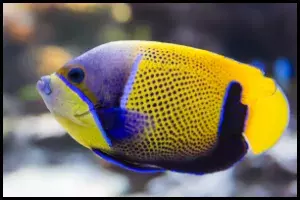

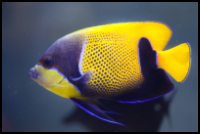
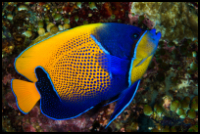
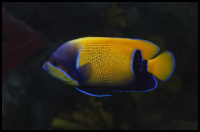
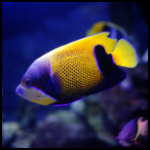
Quick Care Details (Table)
| Livestock Characteristics | Value |
|---|---|
| Care Level | Moderate |
| Temperament | Semi-Aggressive |
| Diet | Omnivore |
| Maximum Size | 1ft |
| Minimum Tank Size | 180 Gallons |
| Reef Compatible | No |
| Temperature Range | 72-78F |
| PH Range | 8.1-8.4 |
| DKH Range | 8-12 |
| Salinity Range | 1.020-1.025 |
Species Specific Categories
Helpful Video
Care Details
Aquascape: Imagine your aquarium as a canvas, and the Blue Girdled Angelfish as the masterpiece. To create the perfect habitat, incorporate live rock formations, coral structures, and caves. This mimics their natural environment, providing hiding spots and enhancing their sense of security.
Substrate: Picture a sandy seabed. It's not just for aesthetics; it's what these angelfish prefer. A sandy substrate allows them to forage comfortably, mirroring their natural habitat.
Disease Prevention: The key to keeping these beauties healthy is pristine water quality. Regular water changes and a quarantine period for new tank additions help prevent diseases. Stay vigilant for signs of stress or illness and take prompt action if necessary.
Filtration: Consider your aquarium's filtration system as its life support. A quality protein skimmer and reliable filtration setup are essential for maintaining water quality and keeping toxins in check.
Lighting: While standard marine aquarium lighting is usually adequate, investing in full-spectrum lighting can enhance their vibrant colors, making them truly shine.
Water Flow: Think of gentle, moderate water flow as a gentle breeze through a garden. These angelfish prefer it. It simulates their natural habitat and creates a comfortable environment.
Hardiness: Blue Girdled Angelfish are typically hardy, making them suitable for intermediate to advanced aquarists. They thrive in stable water conditions, so keep an eye on those parameters.
Acclimation: When introducing them to your aquarium, use the drip acclimation method. It's like helping them get accustomed to their new home slowly, reducing stress during the transition.
Expected Lifespan: Think of these angelfish as long-term companions. With proper care, they can grace your tank for a decade or more, rewarding your commitment.
Special Requirements: These angelfish may occasionally nibble at soft corals and certain invertebrates, so select tank mates carefully. Also, provide a well-rounded diet of marine-based foods to meet their nutritional needs and maintain a stable, well-balanced tank environment.
Temperament and Behavior
Behavior and Social Interaction: The Blue Girdled Angelfish is a real head-turner in the aquatic world, and its behavior matches its elegance. Picture it gliding through the water with a certain grace, exploring the nooks and crannies of your aquarium. These fish are generally peace-loving, making them the perfect addition to a community reef tank. They're the well-mannered guests who get along with other fish, adding charm to the underwater party.
Aggression: Now, let's talk about a little quirk. While they're generally peaceful, some Blue Girdled Angelfish may decide they need a bit of personal space in smaller tanks. It's like marking their territory. But fear not, providing some cool hiding spots can help keep any territorial disputes at bay.
Breeding: Brace yourself for the breeding challenge! Breeding Blue Girdled Angelfish in captivity can be a bit like setting up a romantic date. You need to find the perfect match, create the right ambiance in the tank, and then play the role of a vigilant matchmaker, watching closely as they get to know each other.
Compatibility with Inverts and Fish: The good news is that these angelfish are like the social butterflies of the aquatic world. They typically get along with a variety of invertebrates and fish, making them the life of the underwater party. Just be sure to keep an eye on the guest list and avoid inviting overly aggressive tank mates.
Activity Level: Picture them as the curious explorers of your aquarium. They're moderately active, with a preference for gracefully navigating around the tank. Their favorite spots? Around the rock formations and corals, of course.
Clean-Up Crew: They might not be your typical "clean-up crew" members, but they do have a secret talent. Blue Girdled Angelfish can nibble on certain types of algae, helping keep your tank's aesthetics in check.
Coral Reef Compatibility: They're like the good neighbors of the reef. While they may occasionally nibble at soft corals and some invertebrates, they're not typically considered troublemakers. So, they can be trusted members of your coral community, but keep a watchful eye on the harmony in the tank.
Diet and Nutrition
Dry Foods: Think of dry foods as the pantry staples for your angelfish. They readily accept high-quality marine flake and pellet foods, which should form the foundation of their diet. These can be easily found at your local aquarium store or online.
Frozen Foods: To add variety to their diet, consider offering frozen foods like Mysis shrimp, brine shrimp, and finely chopped seafood. It's like a gourmet treat for your aquatic friends, and they'll appreciate the change in flavors.
Live Foods: Imagine your angelfish going on a hunting expedition within your tank. They relish live foods such as small crustaceans and copepods. Offering live foods now and then replicates the thrill of the hunt and keeps their foraging instincts sharp.
Vegetables: While they're not vegetarians, they may nibble on certain types of algae and seaweed. Think of it as their way of adding a touch of green to their diet. However, it's not their primary food source.
Algae: Blue Girdled Angelfish are like nature's underwater landscapers. They might graze on algae growth in your tank, but it's more of a side dish than the main course. Ensure a well-balanced diet to meet their nutritional needs.
Feeding Schedule: Establish a consistent feeding routine. Think of it like mealtimes for your aquatic companions. Offer small, frequent meals throughout the day. This helps prevent overfeeding and keeps water quality in check.
Supplemental Foods: To ensure their health and vibrancy, consider vitamin-enriched foods designed for marine angelfish. These can provide essential nutrients that may be lacking in their primary diet.
Tank Parameters
Tank Size: Picture an aquarium of at least 75 gallons as the ideal home for your Blue Girdled Angelfish. This size allows them space to swim and explore comfortably.
Tank Length and Measurements: In terms of dimensions, think of a tank that's at least 4 feet in length. It provides ample swimming room, as these angelfish enjoy gliding gracefully through the water.
Species Maximum Size: These angelfish can grow to a maximum size of about 15 inches (38 cm). So, keep in mind their potential growth when planning your tank.
Water Temperature: Imagine the water in your aquarium as a comfortable bath, with temperatures ideally kept between 72°F and 78°F (22°C to 26°C).
pH (Acidity/Alkalinity): Maintaining a pH level around 8.1 to 8.4 is like creating a balanced aquatic environment, ensuring their health and vitality.
Nitrate (NO3) Levels: Consider keeping nitrate levels in check, ideally below 10 ppm. It's like keeping the water fresh and clean, which is essential for their well-being.
Salinity: Aim for a specific gravity of 1.020 to 1.025. This replicates the saltiness of their natural habitat, providing the right conditions for these angelfish.
Phosphate (PO4): To maintain water quality, aim to keep phosphate levels low, ideally below 0.05 ppm.
Alkalinity (dKH): Think of alkalinity as the buffer that helps stabilize pH levels. Aim for alkalinity levels around 8-12 dKH to keep the environment consistent.
History, Popularity, History and Species Variety Details
Table of Contents
The History, Popularity and Natural Habitat
A Glimpse into the Past:
The Blue Girdled Angelfish, scientifically known as Pomacanthus navarchus, is a stunning marine species that has captivated the hearts of aquarium enthusiasts for years. Hailing from the depths of the Indo-Pacific Ocean, they've long been admired for their striking blue hues and distinctive girdle-like patterns. These fish have a history of gracing coral reefs and rocky formations, adding a touch of underwater opulence to the vibrant seas they call home.
A Popularity That Endures:
Their popularity in the aquarium hobby is no surprise. Their striking appearance and peaceful nature make them an attractive choice for marine aquarists. Their vibrant colors, akin to living gems, have made them a sought-after addition to home aquariums. However, it's important to note that their care requirements and compatibility should be well understood before welcoming them into your aquatic world.
Their Natural Underwater World Habitat:
In the warm waters of the Indo-Pacific, these angelfish find their native habitat among coral reefs and rocky formations. Here, they navigate through the intricate underwater architecture, showcasing their elegant beauty amidst vibrant corals and the bustling marine life of the reef. Creating a well-planned aquarium that mimics these natural conditions is key to ensuring their well-being in captivity.
Understanding the historical charm, enduring popularity, and vibrant underwater world these fish call home allows us to appreciate the Blue Girdled Angelfish as a true marvel of the marine realm.
Back to topSimilar Types of Angelfish
- Emperor Angelfish (Pomacanthus imperator): These angelfish share a family resemblance with their striking coloration, including blues, yellows, and whites. They're known for their vibrant appearance and can be equally captivating.
- Regal Angelfish (Pygoplites diacanthus): With their royal blue and yellow patterns, Regal Angelfish are often admired for their beauty. They share a similar elegance with the Blue Girdled Angelfish.
- Koran Angelfish (Pomacanthus semicirculatus): While they have distinct differences, Koran Angelfish can appeal to those who appreciate angelfish with bold patterns and vibrant colors.
- Eibli Angelfish (Centropyge eibli): If you're looking for a smaller angelfish, the Eibli Angelfish offers a touch of elegance with its contrasting colors and patterns.
- Passer Angelfish (Holacanthus passer): These angelfish are known for their striking black and yellow coloration, which gives them a unique and eye-catching appearance.
- Bellus Angelfish (Genicanthus bellus): Bellus Angelfish exhibit a different kind of beauty with their elongated bodies and subtle coloration. They are often appreciated for their graceful appearance.
- Annularis Angelfish (Pomacanthus annularis): Similar to the Blue Girdled Angelfish, Annularis Angelfish display a girdle-like pattern across their bodies, along with a mix of blue and yellow hues.
- Arabian Angelfish (Pomacanthus asfur): Arabian Angelfish are known for their vivid colors, including blues and yellows, which can rival the beauty of the Blue Girdled Angelfish.
Back to top
Frequently Asked Questions
Do They Display Territorial Behavior?
Blue Girdled Angelfish can establish territories, especially in larger tanks. Provide hiding places to reduce aggression and competition among tank mates.
What Water Parameters Do They Prefer?
Maintain a stable temperature between 72-78°F and a pH level of 8.1-8.4 for their well-being.
Are They Reef-Safe?
They may nip at soft corals and some invertebrates, so exercise caution when adding them to a reef tank. Monitor their behavior closely.
How Long Do Blue Girdled Angelfish Live?
With proper care, they can live for 10 years or more in captivity, making them a long-term commitment for aquarium enthusiasts.
Can I Breed Blue Girdled Angelfish in Captivity?
Breeding them in a home aquarium can be challenging, as it involves complex behaviors and requirements like matching mated pairs and providing a suitable environment for spawning.
Are Blue Girdled Angelfish Suitable for Beginners?
While they are hardy and adaptable, they are best suited for intermediate to advanced aquarists due to their specific dietary needs and tank size requirements.
How Can I Mimic Their Natural Habitat in the Aquarium?
Incorporate live rock structures to create hiding spots and offer a reef-like environment. This will help them feel more at home.
What Tank Size Do They Require?
A tank with a capacity of at least 100 gallons is recommended to provide sufficient swimming space and to accommodate their natural behaviors.
What Should I Feed My Blue Girdled Angelfish?
Their diet should include a variety of marine-based foods, such as high-quality flakes, pellets, live and frozen foods, and even fresh vegetables to maintain their health and vibrancy.
Can I Keep Blue Girdled Angelfish in a Community Tank?
Yes, they are generally peaceful and can thrive in a community of compatible marine species. However, it's important to choose tank mates wisely to avoid aggression.
Can Blue Girdled Angelfish Change Color?
Yes, they can exhibit color variations depending on their mood and environment. They might become lighter or darker in response to stress or changes in their surroundings.
Can I Keep Multiple Blue Girdled Angelfish Together?
Keeping multiple Blue Girdled Angelfish in one tank can be challenging, especially in smaller setups. They can exhibit territorial behavior and may become aggressive toward one another.

